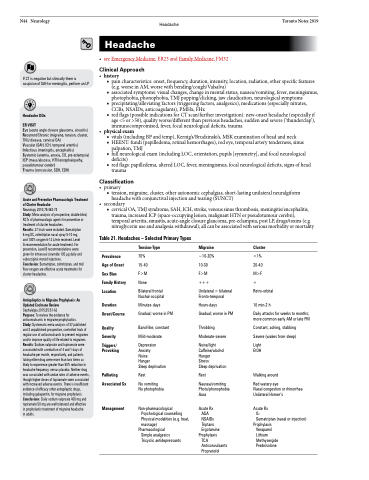Page 786 - TNFlipTest
P. 786
N44 Neurology
Headache
Toronto Notes 2019
If CT is negative but clinically there is suspicion of SAH or meningitis, perform an LP
Headache DDx
ER VISIT
Eye (acute angle closure glaucoma, sinusitis) Recurrent/Chronic (migraine, tension, cluster, TMJ disease, cervical OA)
Vascular (SAH, ICH, temporal arteritis) Infectious (meningitis, encephalitis)
Systemic (anemia, anoxia, CO, pre-eclampsia) ICP (mass/abscess, HTN encephalopathy, pseudotumour cerebri)
Trauma (concussion, SDH, EDH)
Acute and Preventive Pharmacologic Treatment of Cluster Headache
Neurology 2010;75:463-73
Study: Meta-analysis of prospective, double-blind, RCTs of pharmacologic agents for prevention or treatment of cluster headaches.
Results: 27 trials were included. Sumatriptan 6 mg SC, zolmitriptan nasal spray 5-10 mg, and 100% oxygen 6-12 L/min received. Level A recommendation for acute treatment. For prevention, Level B recommendations were given for intranasal civamide 100 μg daily and suboccipital steroid injections.
Conclusion: Sumatriptan, zolmitriptan, and mid flow oxygen are effective acute treatments for cluster headaches.
Antiepileptics in Migraine Prophylaxis: An Updated Cochrane Review
Cephalalgia 2015;35:51-62
Purpose: To review the evidence for anticonvulsants in migraine prophylactics.
Study: Systematic meta-analysis of 37 published and 3 unpublished prospective, controlled trials of regular use of anticonvulsants to prevent migraines and/or improve quality of life related to migraines. Results: Sodium valproate and topiramate were associated with a reduction of 4 and 1 days of headache per month, respectively, and patients taking either drug were more than two times as likely to experience greater than 50% reduction in headache frequency, versus placebo. Neither drug was associated with undue rates of adverse events, though higher doses of topiramate were associated with increased adverse events. There is insufficient evidence of efficacy other antiepileptic drugs, including gabapentin, for migraine prophylaxis. Conclusions: Daily sodium valproate 400 mg and topiramate 50 mg are well tolerated and effective in prophylactic treatment of migraine headache
in adults.
Headache
• seeEmergencyMedicine,ER23andFamilyMedicine,FM32
Clinical Approach
• history
■ pain characteristics: onset, frequency, duration, intensity, location, radiation, other specific features
(e.g. worse in AM, worse with bending/cough/Valsalva)
■ associated symptoms: visual changes, change in mental status, nausea/vomiting, fever, meningismus,
photophobia, phonophobia, TMJ popping/clicking, jaw claudication, neurological symptoms
■ precipitating/alleviating factors (triggering factors, analgesics), medications (especially nitrates,
CCBs, NSAIDs, anticoagulants), PMHx, FHx
■ red flags (possible indications for CT scan/further investigation): new-onset headache (especially if
age <5 or >50), quality worse/different than previous headaches, sudden and severe (‘thunderclap’),
immunocompromised, fever, focal neurological deficits, trauma • physicalexam
■ vitals (including BP and temp), Kernig’s/Brudzinski’s, MSK examination of head and neck
■ HEENT: fundi (papilledema, retinal hemorrhages), red eye, temporal artery tenderness, sinus
palpation, TMJ
■ full neurological exam (including LOC, orientation, pupils [symmetry], and focal neurological
deficits)
■ red flags: papilledema, altered LOC, fever, meningismus, focal neurological deficits, signs of head
trauma
Classification
• primary
■ tension, migraine, cluster, other autonomic cephalgias, short-lasting unilateral neuralgiform
headache with conjunctival injection and tearing (SUNCT) • secondary
■ cervicalOA,TMJsyndrome,SAH,ICH,stroke,venoussinusthrombosis,meningitis/encephalitis, trauma, increased ICP (space-occupying lesion, malignant HTN or pseudotumour cerebri), temporal arteritis, sinusitis, acute-angle closure glaucoma, pre-eclampsia, post LP, drugs/toxins (e.g. nitroglycerin use and analgesia withdrawal); all can be associated with serious morbidity or mortality
Table 21. Headaches – Selected Primary Types
Prevalence Age of Onset Sex Bias Family History Location
Duration Onset/Course
Quality
Severity
Triggers/ Provoking
Palliating Associated Sx
Management
Tension-Type
70%
15-40
F>M
None
Bilateral frontal Nuchal-occipital
Minutes-days Gradual; worse in PM
Band-like; constant Mild-moderate
Depression Anxiety
Noise
Hunger
Sleep deprivation
Rest
No vomiting No photophobia
Non-pharmacological Psychological counselling Physical modalities (e.g. heat, massage)
Pharmacological
Simple analgesics Tricyclic antidepressants
Migraine
~10-20%
10-30
F>M
+++
Unilateral > bilateral Fronto-temporal
Hours-days
Gradual; worse in PM
Throbbing Moderate-severe
Noise/light Caffeine/alcohol Hunger
Stress
Sleep deprivation Rest
Nausea/vomiting Photo/phonophobia Aura
Acute Rx ASA
NSAIDs Triptans Ergotamine
Prophylaxis TCA
Anticonvulsants Propranolol
Cluster
<1%
20-40
M>F
+ Retro-orbital
10 min-2 h
Daily attacks for weeks to months; more common early AM or late PM
Constant, aching, stabbing
Severe (wakes from sleep)
Light EtOH
Walking around
Red watery eye
Nasal congestion or rhinorrhea Unilateral Horner’s
Acute Rx O2
Sumatriptan (nasal or injection) Prophylaxis
Verapamil Lithium Methysergide Prednisolone


